
myCBSEguide App
Download the app to get CBSE Sample Papers 2023-24, NCERT Solutions (Revised), Most Important Questions, Previous Year Question Bank, Mock Tests, and Detailed Notes.
Install NowDownload CBSE sample paper for class 11 Biology from myCBSEguide. Sample paper for class 11 Biology are available for download in myCBSEguide app, the best app for CBSE students. Sample Paper for class 11 Biology includes questions from Biology(Published by NCERT), Other related books and manuals brought out by NCERT(consider multimedia also).
Download Complete set of sample paper for class 11 Biology
For study on the go download myCBSEguide app for android phones. Sample paper for class 11 Biology and other subjects are available for download as PDF in app too.
Biology Sample papers
Here is Sample paper for class 11 Biology. To get the answers and more sample papers, visit myCBSEguide App or website stated above.
Sample Paper for class class 11 Biology
Session 2017-2018
Time allowed: 3 hours, Maximum Marks: 70
General Instructions:
a. The question paper comprises of five Sections A, B, C, D and E.
b. All questions are compulsory.
c. There is no overall choice. However, internal choice has been provided in one question of 2 marks, one question of 3 marks and all the two questions of 5 marks category. Only one option in such question is to be attempted.
d. Questions 1 to 5 in section A are very short questions of one mark each. These are to be answered in one word or one sentence each.
e. Questions 6 to 9 in section B are short questions of two marks each. These are to be answered in approximately 20-30 words each.
f. Questions 10 to 20 in section C are questions of three marks each. These are to be answered in approximately 30-50 words each. Question 21 is of 4 marks.
g. Questions 22 to 23 in section D are questions of five marks each. These are to be answered in approximately 80-120 words each.
h. Questions 24 to 26 in section E is based on OTBA of 10 marks.
Section – A
1. What are the functions of major proteins?
Ans. Fibrinogen, Globulins and Albumins are the major proteins. Fibrinogens are needed for clotting or coagulation of blood. Globulins primarily are involved in defense mechanisms of the body and the Albumins help in osmotic balance.
2. Give two similarities of kingdom monera and protista.
Ans. (a) Both the kingdom contains unicellular organisms.
(b) Both of them includes aquatic organisms.
3. Define cell cycle.
Ans. The sequence of events by which a cell duplicates its genome, synthesizes the other constituents of the cell and eventually divides into two daughter cells is termed as cell cycle.
4. What are micro and macro nutrients? Give examples.
Ans. Macronutrients are generally present in plant tissues in large amounts. For example- C, H, N, P, S, K etc.
Micronutrients or trace elements are needed in very small amounts. These include Fe, Mg, Cu, Mb, Zn etc.
5. Define the term ‘vernalization’.
Ans. There are plants for which flowering is either quantitatively or qualitatively dependent on exposure to low temperature. This phenomenon is termed as vernalization.
Section – B
6. How is the gut lining protected from its own secretion of proteases?
Ans. Proteases are secreted in inactive form and pose no threat to the gut lining. The mucus provides protection to the epithelial lining.
7. What are the different ways in which specimens are kept in a museum?
Or
Differentiate between ascus and basidia, apart from the names of the groups producing them.
Ans. a) The specimens are kept in suitable chemical solutions.
b) Plant and animal specimens are also preserved as dry specimens.
c) Insects are normally dried and pinned in the insect boxes.
d) Larger animals (birds, mammals) are preserved as stuffed specimens.
Or
| Ascus | Basidia |
| Spores are produced endogenously. | Spores are produced exogenously. |
| Eight spores are inside an ascus. | Four spores are produced by a basidium. |
8. Cell is the basic unit of the life. Discuss.
Ans. Every animal or plant is made of many systems. Every system is made of many organs. Organs are made of many types of tissues and tissues are made of many cells. A cell is an autonomous structure and is capable of carrying out various functions on its own. A cell can do all an organism can do. In a sense cell is full of life at the minutest possible level. That is why a cell is called the basic unit of life.
9. How does water scarcity affect the rate of photosynthesis?
Ans. Water is one of the major factors in photosynthesis. When water is the limiting factor, it affects the opening and closing of the stomata and entry of carbon dioxide get restricted and the cells lose their turgidity, thus reduces photosynthesis rate.
Section – C
10. Write six distinguishing features of class Mammalia.
Ans. (a) Presence of mammary glands is a characteristic feature. They are functional in females and vestigial in males.
(b) External ear is present.
(c) Trunk is internally partitioned by a muscular diaphragm into thoracic and abdominal cavities.
(d) Skin possesses sweat glands and sebaceous glands. Skin has hairs, a unique feature of the class.
(e) Heart is four-chambered with two auricles and two ventricles. There is double circulation.
(f) Animals are viviparous and give birth to young ones. The foetus is nourished by the mother through the placenta.
11. Describe the quaternary structure of proteins.
Ans. When a protein has many sub units (polypeptide) each having a primary, secondary or tertiary structure of its own then the protein is said to be in its quaternary structure. E.g Haemoglobin, Insulin, Myoglobin.
12. Describe the auto-regulation of GFR.
Ans. Juxtaglomerular apparatus (JGA) is a specialized cellular structure located where the distal convoluted tubule passes close to the Bowman’s capsule near the afferent article, where the two come in contact with each other. A fall in the GFR activities the cells of TGA to release rennin. Rennin acts through a complex series of reactions called renin-angiotensin-aldosterone mechanism. This increases the blood volume and blood pressure and the GFR is brought back to normal.
13. Draw the diagram of six different shapes of the cells.
Ans.
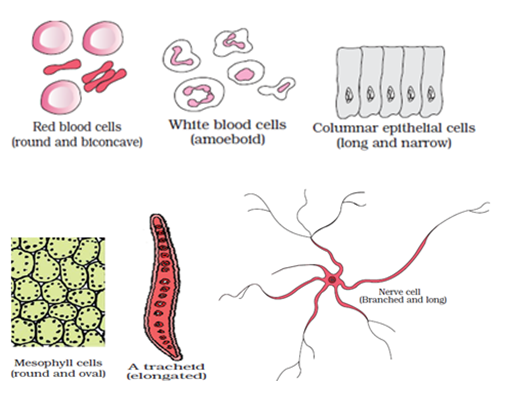
14. Enumerate the chemical events that occur in the process of clotting of blood.
Ans. When blood comes out of a blood vessel, the platelets clump together, break and release platelet factors, thromboplastin. The prothrombin initiates the conversion of prothombin in to thrombin. Thrombin catalyses the conversion of fibrinogen into fibrin which forms a mesh/network in which blood cells get enlarged. Ca++ ions are necessary for both the above reactions.
15. Write any four differences between collenchyma and sclerenchyma.
Ans.
| Collenchyma | Sclerenchyma |
| The cells are alive at maturity. | The cells are dead at maturity. |
| Cell wall is unevenly thickened, thickening are prominent in the corners. | Cell wall is unevenly thickened; sometimes lumen in obliterated. |
| It gives strength and flexibility to growing organs. | It gives mechanical support to the organ and the fibres are used for making threads. |
| It may have chloroplast and perform photosynthesis. | It doesn’t have chloroplast. |
16. Draw a labelled diagram of Nostoc.
Ans. Nostoc
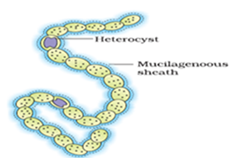
17. Define RQ. Show its value for fats and carbohydrates.
Ans. Respiratory Quotient is defined as the ratio of the volume of carbon dioxide evolved to the volume of oxygen consumed in respiration. RQ varies with the respiratory substrates, as shown below:
(i) When a carbohydrate is the respiratory substrate the RQ is 1.

(ii) When fats are the respiratory substrate the RQ is less than 1.

18. Describe the nervous system of an earthworm.
Or
Draw a labelled diagram of the female reproductive system of frog.
Ans. A brain is formed by the fusion of a pair of supra-pharyngeal / cerebral ganglia; it lies in the anterior and dorsal part of the third segment. It is connected to two sub-pharyngeal ganglia lying below the pharynx with the help of a pair of circum-pharyngeal connectives, which form a nerve ring. A double ventral nerve cord runs up to the last segment. Ganglia are segmentally arranged on the nerve cord.
Or
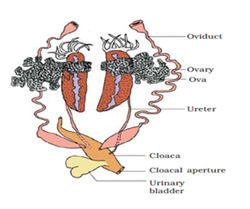
19. What was Van Niel’s experiment? What was the finding from it? Give the equation of photosynthesis given by him.
Ans. He employed purple and green photosynthetic bacteria. He demonstrated that photosynthesis is essentially a light-dependent reaction in which hydrogen from a suitable oxidizable compound reduces carbon dioxide to carbohydrates.
This can expressed as 2 H2A + CO2 {tex}\to {/tex} 2 A + CH2O + H2O.
Green plants, water is the hydrogen donor as it is oxidized to oxygen. Photosynthetic bacteria used hydrogen sulphide (H2S) as hydrogen donor and so the oxidation product is sulphur or sulphate depending on the organism.
20. What are kinetochores? What are their functions?
Ans. Kinetochores are small disc shaped structures at the surface of centromere. They serve as the sites of attachment of the spindle fibres to the centromere of chromosomes. The centromere play important role in cell division.
21. Ram Prakash is a small farmer in a remote village. His daughter name is Shanti. Ram Prakash fixed the marriage of his daughter at the age of 15 but Shanti wants to study further. She discussed the matter with her teacher who lived in same village. Next day the teacher meets Santi’s father and convinced him about the importance of study and disadvantage of early marriage. Finally Ram Prakash agreed to continue her study.
a. What values do you find in teacher?
b. Why girl education is more important than boys education?
c. What is the disadvantage of early marriage of girl?
Ans. a) The teacher was caring and responsible.
b) An educated girl child can educate the family more than a boy can do so. Early education is generally carried by mother of the children.
c) Early marriage of girl leads to a lot of health related and economical problems. The body of girl is not able to bear the reproduction related problem.
Section – D
22. Write a note on Imbibition? Explain the mechanism of it in brief.
Or
a) Schematically represent the water movement in the leaf.
b) Draw a labelled diagram showing apoplast and symplast pathway.
Ans. Imbibition is a special type of diffusion when water is absorbed by solids – colloids – causing them to enormously increase in volume. The classical examples of imbibition are absorption of water by seeds and dry wood. The pressure that is produced by the swelling of wood had been used by pre historic man to split rocks and boulders. If it were not for the pressure due to imbibition, seedlings would not have been able to emerge out of the soil into open. Imbibition is also a special type of diffusion since water movement is along a concentration gradient. The seeds and other such materials have almost no water hence they absorb water easily. Water potential gradient between the absorbent and the liquid imbibed is essential for imbibition. In addition, for any substance to imbibe any liquid, affinity between the adsorbent and the liquid is also a pre-requisite.
Or
a) 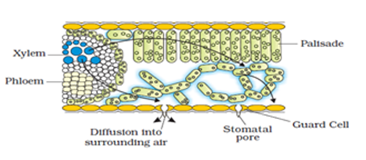
b) 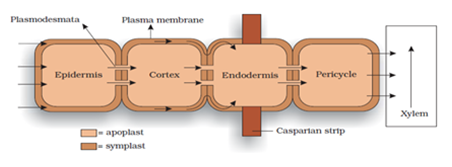
23. Write a note on dicotyledonous seed. With well labelled diagram.
Or
Draw the structure of human brain and label it accurately?
Ans. The outermost covering of a seed is the seed coat. The seed coat has two layers, the outer testa and the inner tegmen. The hilum is a scar on the seed coat through which the developing seeds were attached to the fruit. Above the hilum is a small pore called the micropyle. Within the seed coat is the embryo, consisting of an embryonal axis and two cotyledons. The cotyledons are often fleshy and full of reserve food materials. At the two ends of the embryonal axis are present the radicle and the plumule. In some seeds such as castor, the endosperm formed as a result of double fertilisation, is a food storing tissue. In plants such as bean, gram and pea, the endosperm is not present in mature seeds and such seeds are called nonendospermous.
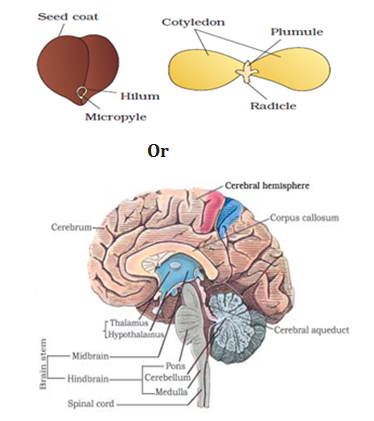
Section-E (OTBA) Questions
24. OTBA Question 2 mark
25. OTBA Question 3 mark
26. OTBA Question 5 mark
This is only initial part of the whole sample paper. Download Complete set of sample paper for class 11 Biology
Sample Paper for class 11
It is Sample paper for class 11 Biology. However, myCBSEguide provides the best sample papers for all the subjects. There are number of sample papers which you can download from myCBSEguide website. Sample paper for class 11 all subjects
- CBSE Sample Papers for Class 11 Physics
- CBSE Sample Papers for Class 11 Chemistry
- CBSE Sample Papers for Class 11 Mathematics
- CBSE Sample Papers for Class 11 Biology
- CBSE Sample Papers for Class 11 Accountancy
- CBSE Sample Papers for Class 11 Economics
- CBSE Sample Papers for Class 11 Business Studies
- CBSE Sample Papers for Class 11 Computer Science
- CBSE Sample Papers for Class 11 Informatics Practices
- CBSE Sample Papers for Class 11 English Core
- CBSE Sample Papers for Class 11 Hindi Core
- CBSE Sample Papers for Class 11 Hindi Elective
- CBSE Sample Papers for Class 11 History
- CBSE Sample Papers for Class 11 Political Science
- CBSE Sample Papers for Class 11 Geography
- CBSE Sample Papers for Class 11 Sociology
- CBSE Sample Papers for Class 11 Physical Education
- CBSE Sample Papers for Other Subjects
These are also Sample Paper for class 11 Biology available for download through myCBSEguide app. These are the latest Sample Paper for class 11 Biology as per the new exam pattern. Download the app today to get the latest and up-to-date study material.
Marking Scheme for Class 11 exam
| Subject | Board Marks | Practical or internal Marks |
| English | 100 Marks | ZERO Marks |
| Hindi | 100 Marks | ZERO Marks |
| Mathematics | 100 Marks | ZERO Marks |
| Chemistry | 70 Marks | 30 Marks |
| Physics | 70 Marks | 30 Marks |
| Biology | 70 Marks | 30 Marks |
| Computer Science | 70 Marks | 30 Marks |
| Informatics Practices | 70 Marks | 30 Marks |
| Accountancy | 80 Marks | 20 Marks |
| Business Studies | 80 Marks | 30 Marks |
| Economics | 80 Marks | 20 Marks |
| History | 80 Marks | 20 Marks |
| Political Science | 100 Marks | ZERO Marks |
| Geography | 70 Marks | 30 Marks |
| Sociology | 80 Marks | 20 Marks |
| Physical Education | 70 Marks | 30 Marks |
| Home Science | 70 Marks | 30 Marks |
Download CBSE Sample Papers
To download complete sample paper for class 11 Biology, Business Studies, Political Science, Economics, Physics, Geography, Computer Science, Home Science, Maths and Chemistry; do check myCBSEguide app or website. myCBSEguide provides sample papers with solution, test papers for chapter-wise practice, NCERT solutions, NCERT Exemplar solutions, quick revision notes for ready reference, CBSE guess papers and CBSE important question papers. Sample Paper all are made available through the best app for CBSE students and myCBSEguide website.

Test Generator
Create question paper PDF and online tests with your own name & logo in minutes.
Create Now
myCBSEguide
Question Bank, Mock Tests, Exam Papers, NCERT Solutions, Sample Papers, Notes
Install Now